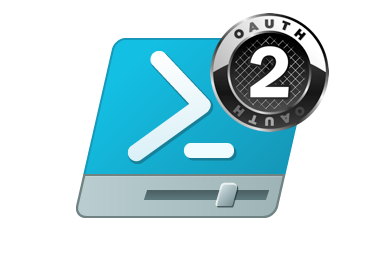This show us the location of our federated authentication endpoint. The token will actually be requested via a SAML user assertion that is received from an STS, in this case ADFS.
The OAuth specification uses the request parameter collection for token and authorization code responses. A username and password combination can be used to directly request a token in the fully managed scenario public client scenario.
A POST request can go directly to the Token endpoint with the following query parameters:
client_id
The Application Id
resource
The Resource URI to access
grant_type
password
username
The username
password
The password
The ADFS/WSTrust will entail sending a SOAP request to the WSTrust endpoint to authenticate and use that response to create the assertion that is exchanged for an access token. Through user realm detection we can find the ADFS username/password endpoint. A SOAP envelope can be sent to endpoint to receive a security token response, containing the assertions needed.
A POST request is sent to the Username/Password endpoint for ADFS with the following envelope with noteable values encased in {}:
<s:Envelope xmlns:s='http://www.w3.org/2003/05/soap-envelope'
xmlns:a='http://www.w3.org/2005/08/addressing'
xmlns:u='http://docs.oasis-open.org/wss/2004/01/oasis-200401-wss-wssecurity-utility-1.0.xsd'>
<s:Header>
<a:Action s:mustUnderstand='1'>http://docs.oasis-open.org/ws-sx/ws-trust/200512/RST/Issue</a:Action>
<a:messageID>urn:uuid:{Unique Identifier for the Request}</a:messageID>
<a:ReplyTo>
<a:Address>http://www.w3.org/2005/08/addressing/anonymous</a:Address>
</a:ReplyTo> <!-- The Username Password WSTrust Endpoint -->
<a:To s:mustUnderstand='1'>{Username/Password Uri}</a:To>
<o:Security s:mustUnderstand='1'
xmlns:o='http://docs.oasis-open.org/wss/2004/01/oasis-200401-wss-wssecurity-secext-1.0.xsd'> <!-- The token length requested -->
<u:Timestamp u:Id='_0'>
<u:Created>{Token Start Time}</u:Created>
<u:Expires>{Token Expiry Time}</u:Expires>
</u:Timestamp> <!-- The username and password used -->
<o:UsernameToken u:Id='uuid-{Unique Identifier for the Request}'>
<o:Username>{UserName to Authenticate}</o:Username>
<o:Password>{Password to Authenticate}</o:Password>
</o:UsernameToken>
</o:Security>
</s:Header>
<s:Body>
<trust:RequestSecurityToken xmlns:trust='http://docs.oasis-open.org/ws-sx/ws-trust/200512'>
<wsp:AppliesTo xmlns:wsp='http://schemas.xmlsoap.org/ws/2004/09/policy'>
<a:EndpointReference>
<a:Address>urn:federation:MicrosoftOnline</a:Address>
</a:EndpointReference>
</wsp:AppliesTo>
<trust:KeyType>http://docs.oasis-open.org/ws-sx/ws-trust/200512/Bearer</trust:KeyType>
<trust:RequestType>http://docs.oasis-open.org/ws-sx/ws-trust/200512/Issue</trust:RequestType>
</trust:RequestSecurityToken>
</s:Body>
</s:Envelope>
The token response is inspected for SAML assertion types (urn:oasis:names:tc:SAML:1.0:assertion or urn:oasis:names:tc:SAML:2.0:assertion) to find the matching token used for the OAuth token request.
<s:Envelope xmlns:s="http://www.w3.org/2003/05/soap-envelope"
xmlns:a="http://www.w3.org/2005/08/addressing"
xmlns:u="http://docs.oasis-open.org/wss/2004/01/oasis-200401-wss-wssecurity-utility-1.0.xsd">
<s:Header>
<a:Action s:mustUnderstand="1">http://docs.oasis-open.org/ws-sx/ws-trust/200512/RSTRC/IssueFinal</a:Action>
<o:Security s:mustUnderstand="1"
xmlns:o="http://docs.oasis-open.org/wss/2004/01/oasis-200401-wss-wssecurity-secext-1.0.xsd">
<u:Timestamp u:Id="_0">
<u:Created>2016-01-03T01:34:41.640Z</u:Created>
<u:Expires>2016-01-03T01:39:41.640Z</u:Expires>
</u:Timestamp>
</o:Security>
</s:Header>
<s:Body>
<trust:RequestSecurityTokenResponseCollection xmlns:trust="http://docs.oasis-open.org/ws-sx/ws-trust/200512"> <!-- Our Desired Token Response -->
<trust:RequestSecurityTokenResponse>
<trust:Lifetime>
<wsu:Created xmlns:wsu="http://docs.oasis-open.org/wss/2004/01/oasis-200401-wss-wssecurity-utility-1.0.xsd">2016-01-03T01:34:41.622Z</wsu:Created>
<wsu:Expires xmlns:wsu="http://docs.oasis-open.org/wss/2004/01/oasis-200401-wss-wssecurity-utility-1.0.xsd">2016-01-03T02:34:41.622Z</wsu:Expires>
</trust:Lifetime>
<wsp:AppliesTo xmlns:wsp="http://schemas.xmlsoap.org/ws/2004/09/policy">
<wsa:EndpointReference xmlns:wsa="http://www.w3.org/2005/08/addressing">
<wsa:Address>urn:federation:MicrosoftOnline</wsa:Address>
</wsa:EndpointReference>
</wsp:AppliesTo>
<trust:RequestedSecurityToken> <!-- The Assertion -->
<saml:Assertion MajorVersion="1" MinorVersion="1" AssertionID="_e3b09f2a-8b57-4350-b1e1-20a8f07b3d3b" Issuer="http://adfs.howtopimpacloud.com/adfs/services/trust" IssueInstant="2016-08-03T01:34:41.640Z"
xmlns:saml="urn:oasis:names:tc:SAML:1.0:assertion">
<saml:Conditions NotBefore="2016-01-03T01:34:41.622Z" NotOnOrAfter="2016-01-03T02:34:41.622Z">
<saml:AudienceRestrictionCondition>
<saml:Audience>urn:federation:MicrosoftOnline</saml:Audience>
</saml:AudienceRestrictionCondition>
</saml:Conditions>
<saml:AttributeStatement>
<saml:Subject>
<saml:NameIdentifier Format="urn:oasis:names:tc:SAML:1.1:nameid-format:unspecified">130WEAH65kG8zfGrZFNlBQ==</saml:NameIdentifier>
<saml:SubjectConfirmation>
<saml:ConfirmationMethod>urn:oasis:names:tc:SAML:1.0:cm:bearer</saml:ConfirmationMethod>
</saml:SubjectConfirmation>
</saml:Subject>
<saml:Attribute AttributeName="UPN" AttributeNamespace="http://schemas.xmlsoap.org/claims">
<saml:AttributeValue>chris@howtopimpacloud.com</saml:AttributeValue>
</saml:Attribute>
<saml:Attribute AttributeName="ImmutableID" AttributeNamespace="http://schemas.microsoft.com/LiveID/Federation/2008/05">
<saml:AttributeValue>130WEAH65kG8zfGrZEFlBQ==</saml:AttributeValue>
</saml:Attribute>
</saml:AttributeStatement>
<saml:AuthenticationStatement AuthenticationMethod="urn:oasis:names:tc:SAML:1.0:am:password" AuthenticationInstant="2016-08-03T01:34:41.607Z">
<saml:Subject>
<saml:NameIdentifier Format="urn:oasis:names:tc:SAML:1.1:nameid-format:unspecified">130WEAH65kG8sfGrZENlBQ==</saml:NameIdentifier>
<saml:SubjectConfirmation>
<saml:ConfirmationMethod>urn:oasis:names:tc:SAML:1.0:cm:bearer</saml:ConfirmationMethod>
</saml:SubjectConfirmation>
</saml:Subject>
</saml:AuthenticationStatement>
<ds:Signature xmlns:ds="http://www.w3.org/2000/09/xmldsig#">
<ds:SignedInfo>
<ds:CanonicalizationMethod Algorithm="http://www.w3.org/2001/10/xml-exc-c14n#" />
<ds:SignatureMethod Algorithm="http://www.w3.org/2000/09/xmldsig#rsa-sha1" />
<ds:Reference URI="#_e3b09f2a-8b57-4350-b1e1-20a8f07b3d3b">
<ds:Transforms>
<ds:Transform Algorithm="http://www.w3.org/2000/09/xmldsig#enveloped-signature" />
<ds:Transform Algorithm="http://www.w3.org/2001/10/xml-exc-c14n#" />
</ds:Transforms>
<ds:DigestMethod Algorithm="http://www.w3.org/2000/09/xmldsig#sha1" />
<ds:DigestValue>itvzbQhlzA8CIZsMneHVR15FJlY=</ds:DigestValue>
</ds:Reference>
</ds:SignedInfo>
<ds:SignatureValue>gBCGUmhQrJxVpCxVsy2L1qh1kMklVVMoILvYJ5a8NOlezNUx3JNlEP7wZ389uxumP3sL7waKYfNUyVjmEpPkpqxdxrxVu5h1BDBK9WqzOICnFkt6JPx42+cyAhj3T7Nudeg8CP5A9ewRCLZu2jVd/JEHXQ8TvELH56oD5RUldzm0seb8ruxbaMKDjYFuE7X9U5sCMMuglU3WZDC3v6aqmUxpSd9Kelhddleu33XEBv7CQNw84JCud3B+CC7dUwtGxwv11Mk/P0t1fGbfs+I6aSMTecKq9YmscqP9tB8ZouD42jhjhYysOQSdulStmUi6gVzQz+c2l2taa5Amd+JCPg==</ds:SignatureValue>
<KeyInfo xmlns="http://www.w3.org/2000/09/xmldsig#">
<X509Data>
<X509Certificate>MIIC4DCDAcigAwIBAgIQaYQ6QyYqcrBBmOHSGy0E1DANBgkqhkiG9w0BAQsFADArMSkwJwYDVQQDEyBBREZTIFNpZ25pbmcgLSBhZGZzLmNpLmF2YWhjLmNvbTAgFw0xNjA2MDQwNjA4MDdaGA8yMTE2MDUxMTA2MDgwN1owKzEpMCcGA1UEAxMgQURGUyBTaWduaW5nIC0gYWRmcy5jaS5hdmFoYy5jb20wggEiMA0GCSqGSIb3DQEBAQUAA4IBDwAwggEKAoIBAQDH9J6/oWYAR8Y98QnacNouKyIBdtZbosEz0HyJVyrxVqKq2AsPvCEO3WFm9Gmt/xQN9PuLidZpgICAe8Ukuv4h/NldgmgtD64mObFNuEM5pzAPRXUv6FWlVE4fnUpIiD1gC0bbQ7Tzv/cVgfUChCDpFu3ePDTs/tv07ee22jXtoyT3N7tsbIX47xBMKgF9ItN9Oyqi0JyQHZghVQ1ebNOMH3/zNdl0WcZ+Pl+osD3iufoH6H+qC9XY09B5YOWy8fJoqf+HFeSWZCHH5vJJfsPTsSilvLHCpMGlrMFaTBKqmv+m9Z3FtbzOcnKHS5PJVAymqLctkH+HbFzaDblaSRhhAgMBAAEwDQYJKoZIhvcNAQELBQADggEBAFB0E2Cj+O24aPM61JsCXLIAB28q4h4qLxMwV+ypYjFxxcQ5GzgqaPJ7BARCnW1gm3PyvNfUut9RYrT9wTJlBVY9WDBoX33jsS87riMj+JONXJ7lG/zAozxs0xIiW+PNlFdOt7xyvYstrFgPJS1E05jhiZ2PR8MS20uSlMNkVPinpz4seyyMQeM+1GbpbDE1EwwtEVKgatJN7t6nAn9mw8cHIk1et7CYOGeWCnMA9EljzNiD8wEwsG51aKfuvGrPK8Q8N/G89SPgstpe0Te5+EtWT6latXfpCwdNWxvinH49SKKa25l1VoLLNwKiQF6vK1Iw0F7dP7QkO5YdE7/MTDU=</X509Certificate>
</X509Data>
</KeyInfo>
</ds:Signature>
</saml:Assertion>
</trust:RequestedSecurityToken>
<trust:RequestedAttachedReference>
<o:SecurityTokenReference k:TokenType="http://docs.oasis-open.org/wss/oasis-wss-saml-token-profile-1.1#SAMLV1.1"
xmlns:o="http://docs.oasis-open.org/wss/2004/01/oasis-200401-wss-wssecurity-secext-1.0.xsd"
xmlns:k="http://docs.oasis-open.org/wss/oasis-wss-wssecurity-secext-1.1.xsd">
<o:KeyIdentifier ValueType="http://docs.oasis-open.org/wss/oasis-wss-saml-token-profile-1.0#SAMLAssertionID">_e3b09f2a-8b57-4350-b1e1-20a8f07b3d3b</o:KeyIdentifier>
</o:SecurityTokenReference>
</trust:RequestedAttachedReference>
<trust:RequestedUnattachedReference>
<o:SecurityTokenReference k:TokenType="http://docs.oasis-open.org/wss/oasis-wss-saml-token-profile-1.1#SAMLV1.1"
xmlns:o="http://docs.oasis-open.org/wss/2004/01/oasis-200401-wss-wssecurity-secext-1.0.xsd"
xmlns:k="http://docs.oasis-open.org/wss/oasis-wss-wssecurity-secext-1.1.xsd">
<o:KeyIdentifier ValueType="http://docs.oasis-open.org/wss/oasis-wss-saml-token-profile-1.0#SAMLAssertionID">_e3b09f2a-8b57-4350-b1e1-20a8f07b3d3b</o:KeyIdentifier>
</o:SecurityTokenReference>
</trust:RequestedUnattachedReference>
<trust:TokenType>urn:oasis:names:tc:SAML:1.0:assertion</trust:TokenType>
<trust:RequestType>http://docs.oasis-open.org/ws-sx/ws-trust/200512/Issue</trust:RequestType>
<trust:KeyType>http://docs.oasis-open.org/ws-sx/ws-trust/200512/Bearer</trust:KeyType>
</trust:RequestSecurityTokenResponse>
</trust:RequestSecurityTokenResponseCollection>
</s:Body>
</s:Envelope>
A POST request is sent to the Token endpoint with the following query parameters:
client_id
The Application Id
resource
The Resource URI to access
assertion
The base64 encoded SAML token
grant_type
urn:ietf:params:oauth:grant-type:saml1_1-bearer urn:ietf:params:oauth:grant-type:saml2-bearer
scope
openid
A GET request is sent to the Authorize endpoint with some similar query parameters:
client_id
The Application Id
redirect_uri
The location within the application to handle the authorization code
response_type
code
prompt
login consent admin_consent
scope
optional scope for access (app uri or openid scope)
The endpoint should redirect you to the appropriate login screen via user realm detection. Once the user login is completed, the code is added to the redirect address as either query parameters (default) or a form POST. Once the code is retrieved it can be exchanged for a token. A POST request is sent to the Token endpoint as demonstrated before with some slightly different parameters:
client_id
The Application Id
resource
The Resource URI to access
code
The authorization code
grant_type
authorization_code
scope
previous scope
client_secret
required if confidential client
Tying it All Together
To try to show some value for your reading time, lets explore how this can be used as the solutions you support and deploy become more tightly integrated with the Microsoft cloud. We'll start by creating a new Native application in the legacy portal.
























